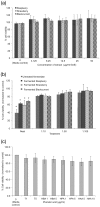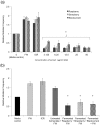Persistence of anticancer activity in berry extracts after simulated gastrointestinal digestion and colonic fermentation
- PMID: 23185422
- PMCID: PMC3504104
- DOI: 10.1371/journal.pone.0049740
Persistence of anticancer activity in berry extracts after simulated gastrointestinal digestion and colonic fermentation
Abstract
Fruit and vegetable consumption is associated at the population level with a protective effect against colorectal cancer. Phenolic compounds, especially abundant in berries, are of interest due to their putative anticancer activity. After consumption, however, phenolic compounds are subject to digestive conditions within the gastrointestinal tract that alter their structures and potentially their function. However, the majority of phenolic compounds are not efficiently absorbed in the small intestine and a substantial portion pass into the colon. We characterized berry extracts (raspberries, strawberries, blackcurrants) produced by in vitro-simulated upper intestinal tract digestion and subsequent fecal fermentation. These extracts and selected individual colonic metabolites were then evaluated for their putative anticancer activities using in vitro models of colorectal cancer, representing the key stages of initiation, promotion and invasion. Over a physiologically-relevant dose range (0-50 µg/ml gallic acid equivalents), the digested and fermented extracts demonstrated significant anti-genotoxic, anti-mutagenic and anti-invasive activity on colonocytes. This work indicates that phenolic compounds from berries undergo considerable structural modifications during their passage through the gastrointestinal tract but their breakdown products and metabolites retain biological activity and can modulate cellular processes associated with colon cancer.
Conflict of interest statement
Figures




Similar articles
-
Comparison of in vivo and in vitro digestion on polyphenol composition in lingonberries: potential impact on colonic health.Biofactors. 2014 Nov-Dec;40(6):611-23. doi: 10.1002/biof.1173. Epub 2014 Oct 30. Biofactors. 2014. PMID: 25359330
-
Bioaccessibility during In Vitro Digestion and Antiproliferative Effect of Bioactive Compounds from Andean Berry ( Vaccinium meridionale Swartz) Juice.J Agric Food Chem. 2018 Jul 18;66(28):7358-7366. doi: 10.1021/acs.jafc.8b01604. Epub 2018 Jul 6. J Agric Food Chem. 2018. PMID: 29913068
-
Stability and biological activity of wild blueberry (Vaccinium angustifolium) polyphenols during simulated in vitro gastrointestinal digestion.Food Chem. 2014 Dec 15;165:522-31. doi: 10.1016/j.foodchem.2014.05.135. Epub 2014 Jun 4. Food Chem. 2014. PMID: 25038707
-
Mechanisms underlying the anti-proliferative effects of berry components in in vitro models of colon cancer.Curr Pharm Biotechnol. 2012 Jan;13(1):200-9. doi: 10.2174/138920112798868773. Curr Pharm Biotechnol. 2012. PMID: 21466426 Review.
-
Berry flavonoids and phenolics: bioavailability and evidence of protective effects.Br J Nutr. 2010 Oct;104 Suppl 3:S67-90. doi: 10.1017/S0007114510003958. Br J Nutr. 2010. PMID: 20955651 Review.
Cited by
-
Common gut microbial metabolites of dietary flavonoids exert potent protective activities in β-cells and skeletal muscle cells.J Nutr Biochem. 2018 Dec;62:95-107. doi: 10.1016/j.jnutbio.2018.09.004. Epub 2018 Sep 15. J Nutr Biochem. 2018. PMID: 30286378 Free PMC article.
-
Photo-fermentation of purple sweet potato (Ipomoea batatas L.) using probiotic bacteria and LED lights to yield functionalized bioactive compounds.3 Biotech. 2018 Jul;8(7):300. doi: 10.1007/s13205-018-1327-7. Epub 2018 Jun 28. 3 Biotech. 2018. PMID: 29963360 Free PMC article.
-
Mind the gap-deficits in our knowledge of aspects impacting the bioavailability of phytochemicals and their metabolites--a position paper focusing on carotenoids and polyphenols.Mol Nutr Food Res. 2015 Jul;59(7):1307-23. doi: 10.1002/mnfr.201400745. Epub 2015 Jun 3. Mol Nutr Food Res. 2015. PMID: 25988374 Free PMC article. Review.
-
Impact of Procyanidins from Different Berries on Caspase 8 Activation in Colon Cancer.Oxid Med Cell Longev. 2015;2015:154164. doi: 10.1155/2015/154164. Epub 2015 Jun 9. Oxid Med Cell Longev. 2015. PMID: 26180579 Free PMC article.
-
A Screening of Native (Poly)phenols and Gut-Related Metabolites on 3D HCT116 Spheroids Reveals Gut Health Benefits of a Flavan-3-ol Metabolite.Mol Nutr Food Res. 2022 Nov;66(21):e2101043. doi: 10.1002/mnfr.202101043. Epub 2022 Apr 26. Mol Nutr Food Res. 2022. PMID: 35394679 Free PMC article.
References
-
- Ferlay J, Shin HR, Bray F, Forman D, Mather C, et al. (2010) Estimates of worldwide burden of cancer in 2008 (GLOBOCAN, 2008). Int J Cancer 127: 2893–28917. - PubMed
-
- van Duijnhoven FJB, Bueno-De-Mesquita HB, Ferrari P, Jenab M, Boshuizen HC, et al. (2009) Fruit, vegetables, and colorectal cancer risk: the European Prospective Investigation into cancer and nutrition. Am J Clin Nut 89: 1441–1452. - PubMed
-
- Duthie SJ (2007) Berry phytochemicals, genomic stability and cancer:evidence for chemoprotection at several stages in the carcinogenic process. Mol. Nutr. Food Res. 51: 665–674. - PubMed
-
- Manach C, Scalbert A, Morand C, Remesy C, Jimenez L (2004) Polyphenols: Food sources and bioavailability. Am J Clin Nutr 79: 727–747. - PubMed
-
- Seeram NP (2008) Berry fruits for cancer prevention: Current status and future prospects. J Agric Food Chem 56: 630–635. - PubMed
Publication types
MeSH terms
Substances
LinkOut - more resources
Full Text Sources

